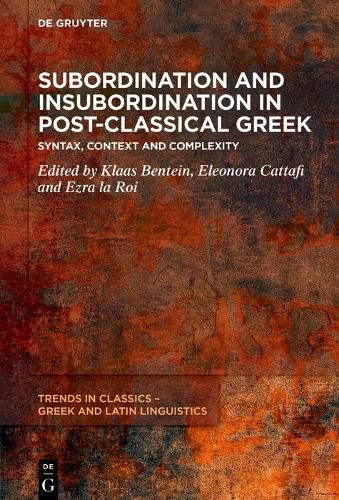Readings Newsletter
Become a Readings Member to make your shopping experience even easier.
Sign in or sign up for free!
You’re not far away from qualifying for FREE standard shipping within Australia
You’ve qualified for FREE standard shipping within Australia
The cart is loading…






This volume presents the first comprehensive analysis of the phenomenon of (in)subordination in Post-Classical Greek (III BCE - VI AD) from a modern linguistic perspective.
The contributions provide new findings into the syntax of the Post-Classical Greek sentence along four main dimensions. First, several studies investigate the diachrony of insubordinate and co-subordinate clause structures, both in Post-Classical Greek and the history of Greek more generally. Second, contributions demarcate the influence of language contact on the continuity and change of clausal strategies. Third, the diverse syntactic and pragmatic factors involved in different types of finite and non-finite subordination are detailed. Fourth, the phenomenon of subordination as found in specific text types and collections is contextualized, incorporating insights from historical sociolinguistics.
This book aims to be of a reference point not only to Greek scholars working on the Post-classical period and the specific corpora addressed in the volume, but also to general linguists interested in the syntax of (in)subordination and the application of modern linguistic approaches to historical languages.
$9.00 standard shipping within Australia
FREE standard shipping within Australia for orders over $100.00
Express & International shipping calculated at checkout
This volume presents the first comprehensive analysis of the phenomenon of (in)subordination in Post-Classical Greek (III BCE - VI AD) from a modern linguistic perspective.
The contributions provide new findings into the syntax of the Post-Classical Greek sentence along four main dimensions. First, several studies investigate the diachrony of insubordinate and co-subordinate clause structures, both in Post-Classical Greek and the history of Greek more generally. Second, contributions demarcate the influence of language contact on the continuity and change of clausal strategies. Third, the diverse syntactic and pragmatic factors involved in different types of finite and non-finite subordination are detailed. Fourth, the phenomenon of subordination as found in specific text types and collections is contextualized, incorporating insights from historical sociolinguistics.
This book aims to be of a reference point not only to Greek scholars working on the Post-classical period and the specific corpora addressed in the volume, but also to general linguists interested in the syntax of (in)subordination and the application of modern linguistic approaches to historical languages.